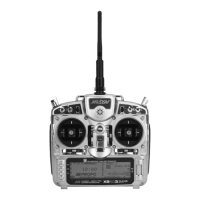1. If using Auto Land, scroll to INH under AUTO LAND
and select it with the Selector. INH will change to
ACT when selected and toggles between ACT and
INH each time the Selector is pressed.
The Auto Land feature, if implemented, automatically
retracts the Flaps and Elevator compensation when the
throttle is raised above a specified throttle position. This
can be useful during a missed landing approach when a
go-around is required. The Flap System allows the Flaps
to be deployed using the Flap Switch, Flight Mode switch
or a combination of both.
2. Scroll down to THRO and press the Selector to
show the throttle percentage. Rotate the selector
until the throttle percentage (0–100%) is equal to
where the Auto Land feature is to retract the Flaps
and Elevator compensation.
You should set the throttle position very high at first
(between 90–99%) to give the aircraft a chance to regain
some speed before the Flaps actually retract. As the Flaps
retract, lift will decrease and the stall speed of the aircraft
will increase and may cause a crash if the airspeed is
too low. When there is a missed approach, advance the
throttle slowly up to about 90% and wait until the aircraft
picks up some speed before advancing the throttle to full,
causing the Flaps to retract.
Highlight and select FLAP SYS. in the FUNC.LIST to
obtain the Flap System display if the aircraft has flaps or
Flaperons that are also going to be used as flaps.
The ELEV values represent the Elevator deflection that
occurs when the Flaps are deployed to their various
positions. Some trial and error will probably be required
to arrive at the right values, but once set, the aircraft will
assume the proper pitch attitude for all flap positions.
1. Make sure the NORM value next to ELEV is set to
0% as there should be no Elevator deflection with
the flaps in their fully retracted (up) position. If it
is not 0%, scroll to NORM next to ELEV, select it,
and then set the value to 0%.
2. Scroll to the Mid parameter beside ELEV and select it.
Set the value either U (up) or D (down) to introduce up
or down Elevator trim for the Mid position of the flaps.
If not sure about which direction, aircraft typically pitch
up when flaps are deployed, requiring some Down
Elevator input to compensate. Use a small percentage
like 3–5% at first and, after test flying, adjust the value
a little at a time until the aircraft maintains the correct
pitch attitude (typically slightly nose down) when the
flaps are deployed to the Mid position.
3. Scroll to the Land parameter beside ELEV on the
display and press the Selector to select it. Set the
value either U (up) or D (down) to introduce a small
amount (5–10%) of up or down Elevator for the Land
position of the flaps, in the same fashion as setting up
the Mid position above.

